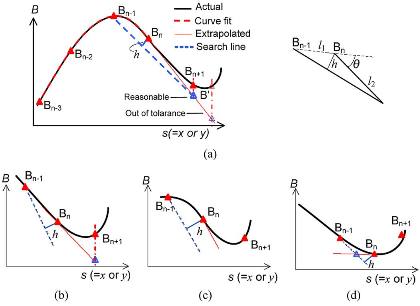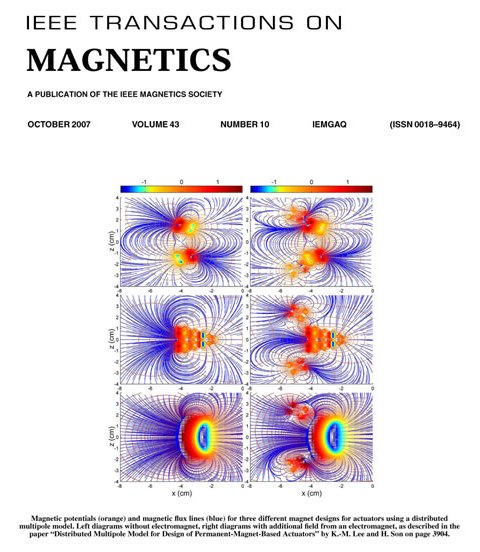Magnetics
| 1980 | 1990 | 2000 | 2010 |
| Emerging of PCs | Information superhighway | Human-center healthcare robotics |
| [Numerical] [Micromagnetics] [Reconstruction] [Dipole models] [Reference] |
Biomechatronics
Adaptive MeshLess Method (MLM) for Design of EM Actuators
Design of electromagnetic actuators often involves solving a magnetic field problem. Papers [1-2] present an adaptive MLM that inherits many advantages of FEM but needs no explicit mesh structure for design analyses:
In paper [1], Lee and Li compared two meshless methods (MLM) of discretizing the computational domain of Poisson-like problems; namely, the point collocation and Gelerkin methods (which use the strong and weak forms of the governing equation respectively), and their effects on the computational accuracy and efficiency of the magnetic fields. Their studies have shown that both methods converge to exact solutions with increasing number of nodes. However, the computation time of MLM is significantly higher than FEM due to the highly nonlinear shape function. While Gelerkin-based MLM offers better overall accuracy, it requires special treatment to approximate the discontinuity of the field intensity, which exhibits oscillations near the discontinuous interface. The discontinuity function added to the MLM improves the accuracy but can not remove the oscillations completely. As the point-collocation MLM requires no meshes and no integration to derive the numerical model, and domain discretization and procedure for imposing the boundary conditions are simple, it represents an interesting tradeoff between the Gelerkin-based MLM and FEM. However, they have also revealed the problems of un-defined normal at the corner in point-collocation MLM, and demonstrated the use of Gauss Integral law to alleviate the problem. This technique estimates the distribution of numerical errors and automatically inserts additional nodes to improve computational accuracy and efficiency.
In paper [2], Li and Lee present an adaptive version of the MLM that inherits many advantages of FEM but needs no explicit mesh structure for design of EM actuators. They offer a technique to estimate the distribution of numerical errors and a scheme automatically inserts additional nodes to improve computational accuracy and efficiency. Comparing the converging speed of the adaptive MLM against a regular MLM (with uniform distributed nodes) shows that the adaptive MLM is effective and computational efficient. To complement and validate the adaptive MLM, they have compared the electromagnetic forces computed using Lorenz law with the field results predicted by the adaptive MLM against published experimental results, which show excellent agreement. They have applied the adaptive MLM to designing of a magnetic actuator for non-contact reorientation of live birds at production speed and for pole design of a spherical motor. (See numerical example.)
MLM in Harmonic Formulation for Micro-magnetic fields
Highly sensitive sensors capable of detecting very weak magnetic fields have a spectrum of applications ranging from small memory devices to biomedical and neuroscience applications. To date, designs of these micro-magnetic MI sensors rely on tedious experimental trial-and-error approaches and/or lumped-parameter models that yield only a first-order accuracy. Domain structures have not unanimously been considered in early MI sensor research, although their existence has been confirmed to play an influential role in the MI-effect sensors. Deploying a meshless method, Eason and Lee offered in [3] an innovative approach to solve in a harmonic formulation the micro-magnetic equations (that take into account, explicitly, the effects of micro-magnetics) for modeling the magnetic fields in an MI sensor element.
In paper [4], we extended the harmonic formulation in such a way that a priori known equilibrium magnetization can be included, and numerically investigated the effects of the Neel walls on the magnetization on the MI ratio of a 2D MI ribbon. Results from our 2D coupled nonlinear model with domain structure not only show quantitative effects consistent with prior published experimental results in literature, but also indicates a radical departure, qualitatively, from decoupled classical models in that the domain structure itself has been shown to influence both the magnetic field intensity, as well as the magnetization amplitudes. Specifically, while relaxing assumptions commonly made in the decoupled linear model that is invalid in the weak external field regime, we provide (for the first time in literature) an intuitive means to analytically visualize the effect of micro-magnetics particularly in the weak field regime —a basis essential to improving the resolution of a MI sensor. These encouraging findings will provide the bases for developing a new interdisciplinary initiative to expand current research into developing MI sensors for detecting very weak (<10E-10T) magnetic fields, which will involve nano-CAE/CAD of magnetic materials.
Paper [5] further takes into accounts the effects of temperature and frequency on the magnetization switching mode in the circular amorphous MI element in the harmonic analysis. Computed results (agreed well with reported experimental data) suggest radial domain walls may play a larger role in the MI effect than originally believed even for the realistic conditions considered here at 1MHz or more.
Magnetic Field Reconstruction (Coupled FEM with measured boundary conditions)
In collaboration with colleagues in Zhejiang University, a computational method based on measured boundary conditions (BCs) to reconstruct physically-accurate magnetic field distributionan has been developed [6]. This method, which relaxes the assumption of known magnetic structures commonly made in the forward models or optimal design problems, only requires the normal component of the magnetic flux density on its boundary surface and has been successfully demonstrated to dry-calibrate an electromagnetic flowmeter [7].
 Paper [8] extends the chord-height method to adaptively determine the measurement points on the boundary surfaces for magnetic field reconstruction;
unlike free-form surfaces of a solid geometry, magnetic distributions are vector fields and invisible.The adaptive method (verified against high-resolution measurements and published data based on gradient method) has been applied to two widely used fluid-to-electrical transducers (electromagnetic velocity probe and flow-meter). Comparisons show that the adaptive method greatly reduces both the number of measuring points and the length of the scanning route. Additionally,
experimental results comparing the calculated sensitivity of an EMF against direct calibration using a standard flow-rig are also presented, which confirm the cost-effectiveness of the dry calibration with reconstructed magnetic fields.
Paper [8] extends the chord-height method to adaptively determine the measurement points on the boundary surfaces for magnetic field reconstruction;
unlike free-form surfaces of a solid geometry, magnetic distributions are vector fields and invisible.The adaptive method (verified against high-resolution measurements and published data based on gradient method) has been applied to two widely used fluid-to-electrical transducers (electromagnetic velocity probe and flow-meter). Comparisons show that the adaptive method greatly reduces both the number of measuring points and the length of the scanning route. Additionally,
experimental results comparing the calculated sensitivity of an EMF against direct calibration using a standard flow-rig are also presented, which confirm the cost-effectiveness of the dry calibration with reconstructed magnetic fields.
While the reconstruction method illustrated here is in the context of electromagnetic fields, the procedure introduced in this paper can be extended to other physical field (such as thermal and electrical) based mechatronic systems, as long as the field obeys similar governing equations (such as Laplace and Poisson equations) with measurable boundary conditions.
References:
-
Lee, K.-M., Q. Li, and H. Son, "Effects of Numerical Formulation on Magnetic Field Computation using Meshless Methods," IEEE Trans. on Magnetics. September 2006, vol. 42, no. 9, pp. 2164-2171.
-
Li, Q. and K.-M. Lee, "An Adaptive Meshless Method for Magnetic Field Computation," IEEE Trans. on Magnetic. August 2006, vol. 42, no. 8, pp. 1996-2003.
-
Eason, K. and K.-M. Lee, "Effects of Nonlinear Micromagnetic Coupling on the Weak-field Magneto-Impedance Sensors," IEEE Trans. on Magnetic. August, 2008, vol. 44, no. 8, pp. 2042-2048.
-
Eason, K. and K.-M. Lee, "A Numerical Investigation of Neel Wall Effects in Amorphous MI Ribbons," IEEE Trans. on Magnetic. May 2009, vol. 45 no. 5, pp. 2059-2067.
-
Eason, K. and, K.-M. Lee, "Effects of Temperature and Frequency on the Magnetization Switching Mode in Circular MI Sensors," Journal of Magnetism and Magnetic Materials. July 2010, vol. 322, no. 13, pp. 1758-1764.
-
Hu, L., K.-M. Lee and X. Fu, "A Magnetic Field Reconstruction Method based on Measured Boundary Conditions for Electromagnetic Mechatronic Systems," IEEE/ASME Trans. on Mechatronics. Aug. 2010, vol. 15, no 4, pp. 595-602.
-
Fu, X. L. Hu, K.-M. Lee and H. Y. Yang, "Dry Calibration of Electromagnetic Flowmeters based on Numerical Models of Multi-physics,"J. of Applied Physics. Oct 2010, vol. 108, no.8, pp. 083908-083908.
-
Hu,. L, K.-M. Lee, J. Zou and H.-Y. Yang, "Adaptive Measurement for Automated Field Reconstruction and Calibration of Magnetic Systems," IEEE Trans. on Automation Sci. and Eng. April 2011, vol. 8, no. 2, pp. 327-337.
-
Lee, K.-M. and H. Son, "Distributed Multipole Model for Design of Permanent-Magnet based Actuators," IEEE Trans. on Magnetics. October 2007, vol. 43, no. 10, pp. 3904-3913. (Featured on the cover page of October 2007 Issue).
-
Lee, K.-M., K. Bai, and J. Lim, "Dipole Models for Forward/Inverse Torque Computation of Spherical Motor," IEEE/ASME Trans. on Mechatronics. Feb 2009, vol 14, no. 1, pp 46-54.
Professor Kok-Meng Lee
George W. Woodruff School of Mechanical
Engineering
Georgia Institute of Technology
Atlanta, GA 30332-0405
Tel: (404)894-7402. Fax: (404)894-9342. Email:
kokmeng.lee@me.gatech.edu
http://www.me.gatech.edu/aimrl/
